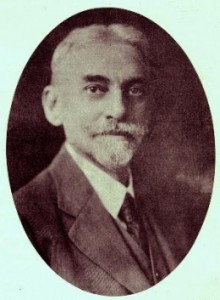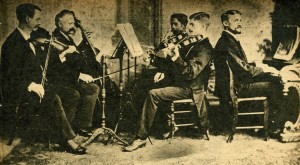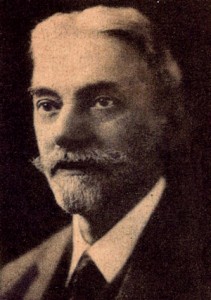 Hubertus Christiaan (Hubert) de Blanck (June 14, 1856 – November 28, 1932 was a Dutch-born professor, pianist, and composer who spent the most and better part of his life in Cuba.
Hubertus Christiaan (Hubert) de Blanck (June 14, 1856 – November 28, 1932 was a Dutch-born professor, pianist, and composer who spent the most and better part of his life in Cuba.
Born in Utrecht, the Netherlands, De Blanck was the son of violinist Willem de Blanck and singer Reine Valet. Hubert studied music with his father until February 1865, when he was admitted to the Royal Conservatory of Liège, Belgium. There he studied piano with Felix Étienne Ledent and solfège. In 1869, aged 13, he won the institution’s 2nd Annual Piano Competition by unanimous decision, the winning piece being Hummel’s Concerto in B minor for piano and orchestra.
After years of different studies and playing all over the world De Blanck and Dengremont soon made their way to the Americas, first Rio de Janeiro in April 1880, where they were received at the court of Emperor Pedro II of Brazil and later Buenos Aires, beginning with a concert at the Politeama on October 3 of that year.
In February 1881, the pianist gave a solo performance in [Buenos Aires, after which he travelled to the United States for a series of concerts. Upon arriving in New York, he performed Weber’s Konzertstück, Op. 79, with the New York Philharmonic, under the direction of Theodore Thomas. He was later awarded the position of Professor of Piano at the New York College of Music, which had previously been held by the professor Rafael Joseffy. In the weeks that followed he met the young Ana María García Menocal (1855–1900), cousin of the future president of Cuba, Mario García Menocal. They were married in New York in November 1881. From this union were born six Cuban children: five sons, Guillermo (Willy), Huberto, Armando, Florencio, Narciso, and a daughter, Rosario.
Leonardo Gell – Composer Hubert de Blanck: “Paráfrasis sobre el Himno Bayamés”
De Blanck visited Havana for the first time in December 1882 along with his wife. There he gave a performance of Anton Rubinstein’s Piano Trio, Op. 52, along with Anselmo Lopez and Serafin Ramirez. Cuba’s most famous artists, among them Ignacio Cervantes, Pablo Desvernine, and Nicolas Ruiz Espadero, applauded the visiting pianist. Upon his return to New York, De Blanck continued to teach and perform in numerous concerts.
February 1883 found De Blanck on the cover of New York’s ‘Musical Courier’, a famous magazine of the time. That same year, he moved to Havana and began a new life with his wife and children.
He immediately began forging relationships with important members of the Cuban arts community, and was soon named president of the Seccion de Philharmonic de ‘La Caridad del Cerro’. In March 1884, he organized and conducted, with assistance from the Governor General, a fundraising festival in the ‘Tacon’ theater to raise money for the construction of the ‘Reina Mercedes’ hospital. The event was an extraordinary success. The following November De Blanck created the ‘Sociedad de Musica Classica’ in conjunction with violinists Jose and Feliz Vandergucht, the cellist Charles Werner, and the violist Tomas de la Rosa.
Fully ensconced in Cuba’s musical community and atmosphere, De Blanck began contemplating Havana’s lack of a dedicated conservatory of music. One day in August 1885, he met with various Cuban professors at the home of Anselmo Lopez and suggested the idea that together they could work on creating a Cuban conservatory of music.
The group convened a number of times but the project stalled. De Blanck then decided to go it alone. He named Gabriel Morales Valverde (‘Edgardo’) conservatory secretary and designated Anselmo Lopez, Ernesto Edelmann, Jose Mungol, Tomas Ruiz, Juan Miguel Joval, and Mariano Cuero its first teachers. Rafael Montoro and Anselmo Lopez were especially instrumental in the project. Soon after, Ramón Suaréz Inclán was named Honorary President for his works as a philanthropist and his dedication to music and the arts.
The new conservatory received funding from ‘La Caridad Del Cerro’, ‘La Disputacion Provincial’, the ‘Real Sociedad Económica’, the National Government, the ‘Ayuntamiento de La Habana’, and opened that September 1885. Originally named the Hubert de Blanck Conservatory, it was later renamed the National Conservatory of Music.
After the death of his first wife in 1900, De Blanck married one of his students, Pilar Martín (1883–1955) in 1902. The couple got three children: Margot, Ernesto and Olga.
Hubert de Blanck died in 1932 at age 76 and was interred in the Colon Cemetery, Havana. Widely acclaimed in Cuba during his lifetime for his significant contribution to the country’s culture, he has since been honored with his image on a Cuban postage stamp. As well, a theatrical company carries his name as does the theatre in the Vedado district of Havana which opened in 1955.
Agencies/Various/InternetPHotos/ The Cuban History.com
The Cuban History, Hollywood.
Arnoldo Varona, Editor.



 Hubert de Blanck, professor, pianist, composer.
Hubert de Blanck, professor, pianist, composer.
